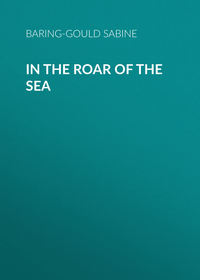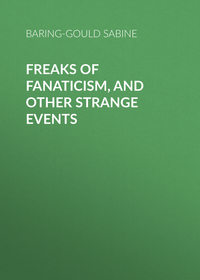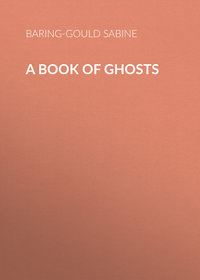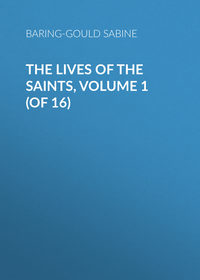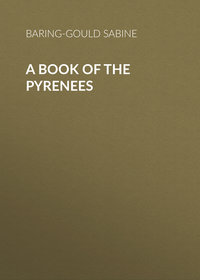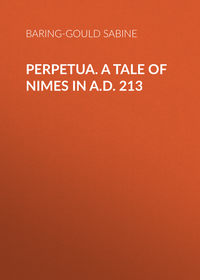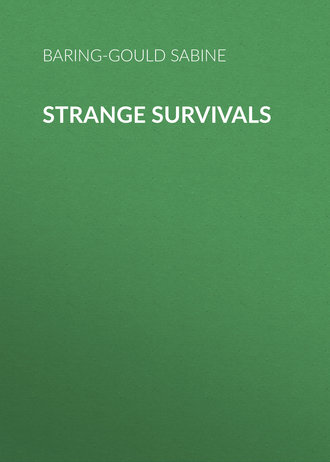 полная версия
полная версияStrange Survivals
So, in Persia, the Divine Ox, Ahidad, was slain that the world might be fashioned out of him; and the Mithraic figures represent this myth. If we put ourselves back in thought to the period when the Gospel was proclaimed, we shall understand better some of its allusions; with this notion of sacrifice underlying all great undertakings, all constructive work, we shall see how some of the illustrations used by the first preachers would come home to those who heard them. We can see exactly how suitable was the description given of Christ as the Lamb that was slain from the foundation of the world. As the World-Lamb, He was the sustainer of the great building, He secured its stability; and just as the sacrifice haunts the building reared on it, so was the idea of Christ to enter into and haunt all history, all mythology, all religion.
We see, moreover, the appropriateness of the symbol of Christ as the chief Corner-stone, and of the Apostles as foundation stones of the Church; they are, as it were, the pise blocks, living stones, on whom the whole superstructure of the spiritual city is reared.
With extraordinary vividness, moreover, does the full significance of the old ecclesiastical hymn for the Dedication of a Church come out when we remember this wide-spread, deeply-rooted, almost ineradicable belief.
“Blessèd city, heavenly Salem,Vision dear of peace and love,Who of living stones upbuilded,Art the joy of heaven above.Many a blow and biting sculpturePolished well those stones elect,In their places now compactedBy the heavenly Architect.Christ is made the sure foundationAnd the precious corner-stone,Who, the twofold walls uniting,Binds them closely into one.”II.
On Gables
The tourist on the Rhine, as a matter of duty, visits in Cologne three points of interest, in addition to providing himself with a little box of the world-famous Eau, at the real original Maria Farina’s factory. After he has “done” the Cathedral, and the bones of the Eleven Thousand Virgins, he feels it incumbent on him to pay a visit to the horses’ heads in the market-place, looking out of an attic window.
Myths attach equally to the Minster, the Ursuline relics, and to the horses’ heads. The devil is said to have prophesied that the cathedral would never be completed, yet lo! it is finished to the last stone of the spires! The bones of the eleven thousand virgins have been proved to have come from an old neglected cemetery, broken into when the mediæval walls of Cologne were erected. It will be shown that the heads of the two grey mares near the Church of the Apostles have a very curious and instructive history attaching to them, and that, though the story that accounts for their presence on top of a house is fabulous, their presence is of extreme interest to the antiquary.
The legend told of these particular heads is shortly this:4 Richmod of Adocht was a wealthy citizen’s wife at Cologne. She died in 1357, and was buried with her jewelry about her. At night the sexton opened her grave, and, because he could not remove the rings, cut her finger. The blood began to flow, and she awoke from her cataleptic fit. The sexton fled panic-stricken. She then walked home, and knocked at her door, and called up the apprentice, who, without admitting her, ran upstairs to his master, to tell him that his wife stood without. “Pshaw!” said the widower, “as well make me believe that my pair of greys are looking out of the attic window.” Hardly were the words spoken, than, tramp – tramp – and his horses ascended the staircase, passed his door, and entered the garret. Next day every passer-by saw their heads peering from the window. The greatest difficulty was experienced in getting the brutes downstairs again. As a remembrance of this marvel, the horses were stuffed, and placed where they are now to be seen.
Such is the story as we take it from an account published in 1816. I had an opportunity a little while ago of examining the heads. They are of painted wood.
The story of the resuscitation of the lady is a very common one, and we are not concerned with this part of the myth. That which occupies us is the presence of the horses’ heads in the window. Now, singularly enough, precisely the same story is told of other horses’ heads occupying precisely similar positions in other parts of Germany. We know of at least a dozen.5 It seems therefore probable that the story is of later origin, and grew up to account for the presence of the heads, which the popular mind could not otherwise explain. This conjecture becomes a certainty when we find that pairs of horses’ heads were at one time a very general adornment of gable ends, and that they are so still in many places.
In Mecklenburg, Pomerania, Luneburg, Holstein, it is still customary to affix carved wooden horse-heads to the apex of the principal gable of the house. There are usually two of these, back to back, the heads pointed in opposite directions. In Tyrol, the heads of chamois occupy similar positions. The writer of this article was recently in Silesia, and sketched similar heads on the gables of wooden houses of modern construction in the “Giant Mountains.” They are also found in Russia.
Originally, in Germany, Norway, Sweden, Denmark, and indeed England, all houses were built of timber, and those which were not of circular form, with bee-hive roofs, had gables. Unfortunately, we have but one very early representation of a Teutonic village, and that is on the Antonine column at Rome. One of the bas-reliefs there shows us the attack by Romans on a German village. The houses are figured as built of wattled sides, and thatched over. Most are of bee-hive shape, but one, that of the chief, is oblong and gabled. The soldiers are applying torches to the roofs, and, provokingly enough, we cannot see the gable of the quadrangular house, because it is obscured by the figure of a German warrior who is being killed by a Roman soldier. Though this representation does not help us much, still there is abundance of evidence to show that the old German houses – at least, those of the chiefs – were like the dwellings of the Scandinavian Bonders, with oblong walls with gables, and with but a single main front and gable a-piece. The Icelandic farmhouses perpetuate the type to the present day, with some modifications. These dwellings have lateral walls of stone and turf scarcely six feet high, and from six to ten feet thick, to bank out the cold. On these low parallel walls rest the principals of the roof, which is turf-covered. The face of the house is to the south, it is the only face that shows; the back is banked up like the sides, so that from every quarter but one a house looks like a grassy mound. The front consists of two or more wooden gables, and is all of wood, often painted red. Originally, we know, there was but a single gable. At present the subsidiary gable is low, comparatively insignificant, and contains the door. Now the old Anglo-Saxon, Norse, and German houses of the chiefs were all originally constructed on the same principle, and the timber and plaster gable fronts of our old houses, the splendid stone and brick-gabled faces of the halls of the trade guilds in the market-place at Brussels, and the wonderful stepped and convoluted house-fronts throughout Holland and Germany, are direct descendants of the old rude oblong house of our common forefathers.
We come now to another point, the gable apex. A gable, of course, is and must be an inverted v,





Among the Anglo-Saxons the


In one Anglo-Saxon miniature representing a nobleman’s house, a stag’s head is at the apex. The old Norwegian wooden church of Wang of the twelfth century, which was bought and transported to the flanks of the Schnee-Koppe in Silesia by Frederick William IV. in 1842, is adorned with two heads of sea-snakes or dragons, one at each end of the gable. In the Rhætian Alps the gables of old timber houses have on them the fore-parts of horses, carved out of the ends of the intersecting principals.
But the horse’s head, sometimes even a human skull, was also affixed to the upright leg of the inverted y– the hipknob,6 as architects term it – partly, no doubt, as a protection of the cross-cut end from rain and rotting. But though there was a practical reason for putting skulls on these exposed timber-ends, their use was not only practical, they were there affixed for religious reasons also, and indeed principally for these.
As a sacrifice was offered when the foundations of a house were laid, so was a sacrifice offered when the roof was completed. The roof was especially subject to the assaults of the wind, and the wind was among the Northmen and Germans, Odin, Woden, or Wuotan. Moreover, in high buildings, there was a liability to their being struck by lightning, and the thunder-god Thorr had to be propitiated to stave off a fire. The farmhouses in the Black Forest to the present day are protected from lightning by poles with bunches of flowers and leaves on the top, that have been carried to church on Palm Sunday, and are then taken home and affixed to the gable, where they stand throughout the year. The bunch represents the old oblation offered annually to the God of the Storm.7 Horses were especially regarded as sacred animals by the Germans, the Norsemen, and by the Slaves. Tacitus tells us that white horses were kept by the ancient Germans in groves sacred to the gods; and gave auguries by neighing. The Icelandic sagas contain many allusions to the old dedication of horses to the gods. Among the Slaves, horses were likewise esteemed sacred animals; swords were planted in the ground, and a horse was led over them. Auguries were taken by the way in which he went, whether avoiding or touching the blades. In like manner the fate of prisoners was determined by the actions of an oracular horse. When a horse was killed at a sacrifice, its flesh was eaten. St. Jerome speaks of the Vandals and other Germanic races as horse-eaters, and St. Boniface forbade his Thuringian converts to eat horse-flesh.
The eating of this sort of meat was a sacramental token of allegiance to Odin. When Hakon, Athelstan’s foster-son, who had been baptised in England, refused to partake of the sacrificial banquet of horse-flesh at the annual Council in Norway, the Bonders threatened to kill him. A compromise was arrived at, so odd that it deserves giving in the words of the saga: “The Bonders pressed the King strongly to eat horse-flesh; and as he would not do so, they wanted him to drink the soup; as he declined, they insisted that he should taste the gravy; and on his refusal, were about to lay hands on him. Earl Sigurd made peace by inducing the King to hold his mouth over the handle of the kettle upon which the fat steam of the boiled horse-flesh had settled; and the King laid a linen cloth over the handle, and then gaped above it, and so returned to his throne; but neither party was satisfied with this.” This was at the harvest gathering. At Yule, discontent became so threatening, that King Hakon was forced to appease the ferment by eating some bits of horse’s liver.
Giraldus Cambrensis says of the Irish that in Ulster a king is thus created: “A white mare is led into the midst of the people, is killed, cut to pieces and boiled; then a bath is prepared of the broth. Into this the King gets, and sitting in it, he eats of the flesh, the people also standing round partake of it. He is also required to drink of the broth in which he has bathed, lapping it with his mouth.” (“Topography of Ireland,” c. xxv.) This is, perhaps, the origin of the Irish expression, “a broth of a boy.”
Tacitus tells us that after a defeat of the Chatti, their conquerors sacrificed horses, ate their flesh, and hung up their heads in trees, or affixed them to poles, as offerings to Wuotan. So, after the defeat of Varus and his legions, when Cæcina visited the scene of the disaster, he found the heads of the horses affixed to the branches and trunks of the trees. Gregory the Great, in a letter to Queen Brunehild, exhorted her not to suffer the Franks thus to expose the heads of animals offered in sacrifice. At the beginning of the fifth century, St. Germanus, who was addicted to the chase before he was made Bishop of Auxerre, was wont to hang up the heads and antlers of the game killed in hunting in a huge pear-tree in the midst of Auxerre, as an oblation to Odin, regardless of the reproof of his bishop, Amator, who, to put an end to this continuance of a heathenish ceremony, cut down the tree.
Adam of Bremen tells of the custom of hanging men, horses, and dogs at Upsala; and a Christian who visited the place counted seventy-two bodies. In Zeeland, in the eleventh century, every ninth year, men, horses, dogs, and cocks were thus sacrificed, as Dietmar (Bishop of Merseburg) tells us. Saxo, the grammarian, at the end of the twelfth century, describes how horses’ heads were set up on poles, with pieces of wood stuck in their jaws to keep them open. The object was to produce terror in the minds of enemies, and to drive away evil spirits and the pestilence. For this reason it was, in addition to the practical one already adduced, that the heads of horses, men, and other creatures which had been sacrificed to Odin were fastened to the gables of houses. The creature offered to the god became, so to speak, incorporate in the god, partook of the Divine power, and its skull acted as a protection to the house, because that skull in some sort represented the god.
In the Egil’s saga, an old Icelandic chief is said to have taken a post, fixed a horse’s head on the top, and to have recited an incantation over it which carried a curse on Norway and the King and Queen; when he turned the head inland, it made all the guardian spirits of the land to fly. This post he fixed into the side of a mountain, with the open jaws turned towards Norway.8 Another Icelander took a pole, carved a human head at the top, then killed a mare, slit up the body, inserted the post and set it up with the head looking towards the residence of an enemy.9
These figures were called Nith-stangs, and their original force and significance became obscured. The nith-stang primarily was the head of the victim offered in sacrifice, lifted up with an invocation to the god to look on the sacrifice, and in return carry evil to the houses of all those who wished ill to the sacrificer. The figure-head of a war-ship was designed in like manner, to strike terror into the opponents, and scare away their guardian spirits. The last trace of the nith-stang as a vehicle of doing ill was at Basle, where the inhabitants of Great and Little Basle set up figures at their several ends of the bridge over the Rhine to outrage each other.
In Ireland we meet with similar ideas. On the death of Laeghaire (King Lear), his body was carried to Tara and interred with his arms and cuirass, and with his face turned towards his enemies, as if still threatening them. Eoghan, King of Connaught, was so buried in Sligo, and as long as his dead head looked towards Ulster, the Connaught men were victorious; so the Ulster men disinterred him and buried him face downwards, and then gained the victory. According to Welsh tradition, the head of Bran was buried with the face to France, so that no invasion could come from thence. A Welsh story says that the son of Lear bade his companions cut off his head, take it to the White Hill in London, and bury it there, with the face directed towards France. The head of man and beast, when cut off, was thought to be gifted with oracular powers, and the piping of the wind in the skulls over the house gables was interpreted – as he who consulted it desired.
In an account we have of the Wends in the fifteenth century, we are told that they set up the heads of horses and cows on stakes above their stables to drive away disease from their cattle, and they put the skull of a horse under the fodder in the manger to scare away the hobgoblins who ride horses at night. In Holland, horses’ heads are hung up over pigstyes, and in Mecklenburg they are placed under the pillows of the sick to drive away fever. It must be remembered that pest or fever was formerly, and is still among the superstitious Slaves, held to be a female deity or spirit of evil.
Now we can understand whence came the headless horses, so common in superstition, as premonitions of death. Sometimes a horse is heard galloping along a road or through a street. It is seen to be headless. It stops before a door, or it strikes the door with its hoof. That is a sure death token. The reader may recall Albert Dürer’s engraving of the white horse at a door, waiting for the dead soul to mount it, that it may bear him away to the doleful realms of Hæla. In Denmark and North Germany the “Hell-horse” is well known. It has three legs, and is not necessarily headless. It looks in at a window and neighs for a soul to mount it. The image of Death on the Pale Horse in the Apocalypse was not unfamiliar to the Norse and German races. They knew all about Odin’s white horse that conveyed souls to the drear abode.
Properly, every village, every house had its own hell-horse. Indeed, it was not unusual to bury a live horse in a churchyard, to serve the purpose of conveying souls. A vault was recently opened in a church at Görlitz, which was found to contain a skeleton of a horse only, and this church and yard had long been believed to be haunted by a hell-horse. The horse whose head was set up over the gable of a house was the domestic spirit of the family, retained to carry the souls away.
The child’s hobby-horse is the degraded hell-horse. The grey or white hobby was one of the essential performers in old May Day mummings, and this represents the pale horse of Odin, as Robin Hood represents Odin himself.10 We see in the hobby-horse the long beam of the principal with the head at the end. It was copied therefrom, and the copy remains long after the original has disappeared from among us.
A man was on his way at night from Oldenburg to Heiligenhafen. When he came near the gallows-hill he saw a white horse standing under it. He was tired, and jumped on its back. The horse went on with him, but became larger and larger at every step, and whither that ghostly beast would have carried him no one can say; but, fortunately, the man flung himself off the back. In Sweden the village of Hästveda is said to take its name from häst-hvith, a white horse which haunts the churchyard and village.
In Bürger’s ballad of Leonore, the dead lover comes riding at night to the door of the maiden, and persuades her to mount behind him. Then the horse dashes off.
“How fast, how fast, fly darting pastHill, mountain, tree, and bower;Right, left, and right, they fly like light,Hamlet, and town, and tower.‘Fear’st thou, my love? The moon shines bright.Hurrah! the dead ride fast by night,And dost thou dread the silent dead?’”They dash past a graveyard in which is a mourning train with a coffin. But the funeral is interrupted; the dead man must follow horse and rider.
They pass a gallows, round which a ghostly crew are hovering. The hanging men and the spectral dance must follow.
The rider carries his bride to a churchyard, and plunges down with her into a vault.
Bürger has utilised for his ballad a tradition of Woden as the God of the Dead, carrying off the souls on his hell-horse. The story is found in many places; amongst others in Iceland, and variously modified.
The nightmare is the same horse coming in and trampling on the sleeper’s chest. The reader will remember Fuseli’s picture of the head of the spectre horse peering in at the sleeper between the curtains of her bed, whilst an imp sits on and oppresses her bosom.
But the horse is not always ridden. Modern ideas, modern luxury, have invaded the phantom world, and now – we hear of death-coaches drawn by headless horses. These are black, like mourning carriages, and the horses are sable; a driver sits on the box; he is in black, but he has no weeper to his hat, because he has not a hat. He has not a hat, because he is without a head. The death-coach is sometimes not seen, but heard. At others it is seen, not heard. It rolls silently as a shadow along the road.
But, indeed, Woden had a black horse as well as one that was white. Rime-locks (Hrimfaxi) was his sable steed, and Shining-locks (Skinfaxi) his white one. The first is the night horse, from whose mane falls the dew; the second is the day horse, whose mane is the morning light. One of the legends of St. Nicholas refers to these two horses, which have been transferred to him when Woden was displaced. The saint was travelling with a black and a white steed, when some evil-minded man cut off their heads at an inn where they were spending the night. When St. Nicholas heard what had been done, he sent his servant to put on the heads again. This the man did; but so hurriedly and carelessly, that he put the black head on the white trunk, and vice versâ. In the morning St. Nicholas saw, when too late, what had been done. The horses were alive and running. This legend refers to the morning and the evening twilights, part night and part day. The morning twilight has the body dark and the head light; and the evening twilight has the white trunk and the black head.
St. Nicholas has taken Odin’s place in other ways. As Saint Klaus he appears to children at Yule. The very name is a predicate of the god of the dead. He is represented as the patron of ships; indeed, St. Nicholas is a puzzle to ecclesiastical historians – his history and his symbols and cult have so little in common. The reason is, that he has taken to him the symbols, and myths, and functions of the Northern god. His ship is Odin’s death-ship, constructed out of dead men’s finger and toe-nails.
In Denmark, a shovelful of oats is thrown out at Yule for Saint Klaus’s horse; if this be neglected, death enters the house and claims a soul. When a person is convalescent after a dangerous illness, he is said to have “given a feed to Death’s Horse.” The identification is complete. Formerly, the last bundle of oats in a field was cast into the air by the reapers “for Odin at Yule to feed his horse.” And in the writer’s recollection it was customary in Devon for the last sheaf to be raised in the air with the cry, “A neck Weeday!” That is to “Nickar Woden.”


